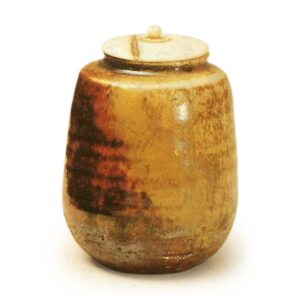
Chuko Meibutsu. Hafu-gama tea caddy, Masaki Tebonya. The vine of the Masaki tree turns red in winter, and this tea caddy was named Masaki because of its resemblance to the scene when the leaves of the Masaki tree are about to turn yellow and red after they tire of frost. The Hikka is “Miyama ni arare fururashi soto yama naru shouki no kazura kakizukini keri” in “Kokinshu” and “Kannushi Tsuki Shigure Fururashi Sahoyama no Shouki no kazura iro masari go” in “Shin Kokinshu”. The steamer is low, the shoulders are not angry and slightly swollen, and the body below the shoulders is very ordinary. The body is covered with wheel-thrown patterns, and there is a broad yellow glaze which is peculiar to kafu in the black ame glaze. The clay below the base has a reddish tinge. The thread cutting is a little rough. The provenance is as follows. Kobori Enshu, Tsuchiya Sagamimori, Hosokawa Echu-no-Mamoru, Shimabara domain lord Matsudaira Shudenohashira, and Tokyo Nezu Kaichiro’s family. Currently in the collection of the Nezu Museum. (Meibutsu Ki, Kokin Meibutsu Ruiju, Taisho Meikikan)



